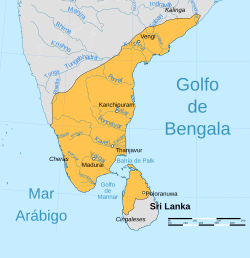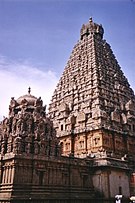
Back سلالة بانديا Arabic পাণ্ড্য ৰাজবংশ Assamese পাণ্ড্য রাজবংশ Bengali/Bangla Pandya Catalan Pandya German Dinastía Pandya Spanish Empire Pandya French પાંડિયન વંશ Gujarati पाण्ड्य राजवंश Hindi Dinasti Pandya ID
Pandyan dynasty Pāṇṭiya Pēraracu | |||||||||||||||
|---|---|---|---|---|---|---|---|---|---|---|---|---|---|---|---|
| 400 B.C.E.–1618 | |||||||||||||||
|
A close depiction of Tenkasi Pandiya flag as per archaeological findings and historians illustration.[1] | |||||||||||||||
 The Pandya dynasty at its greatest extent in 1290 CE under Maravarman Kulasekara Pandyan I. | |||||||||||||||
| Capital | |||||||||||||||
| Official languages | Tamil Sanskrit[4][5] | ||||||||||||||
| Religion | |||||||||||||||
| Demonym(s) | Pandiyar | ||||||||||||||
| Government | Monarchy | ||||||||||||||
• Around 270 BCE | Nedunjeliyan I (first documented) | ||||||||||||||
• 560–590 CE | Kadungon (Pandya revival) | ||||||||||||||
• 1613–1618 CE | Varagunarama | ||||||||||||||
| Historical era | Medieval era | ||||||||||||||
• Established | 400 B.C.E. | ||||||||||||||
• Disestablished | 1618 | ||||||||||||||
| |||||||||||||||
| Today part of | India Sri Lanka | ||||||||||||||
| Part of a series on |
| History of Tamil Nadu |
|---|
 |
| History of South Asia |
|---|
 |
The Pandyan dynasty, (Tamil: [paːɳɖijɐr]) also referred to as the Pandyas of Madurai, was an ancient Tamil dynasty of South India, and among the four great kingdoms of Tamilakam, the other three being the Pallavas, the Cholas and the Cheras.[8] Existing since at least the 4th to 3rd centuries BCE, the dynasty passed through two periods of imperial dominance, the 6th to 10th centuries CE, and under the 'Later Pandyas' (13th to 14th centuries CE). Under Jatavarman Sundara Pandyan I and Maravarman Kulasekara Pandyan I, the Pandyas ruled extensive territories including regions of present-day South India and northern Sri Lanka through vassal states subject to Madurai.[9][10]
The rulers of the three Tamil dynasties were referred to as the "three crowned rulers (the mu-ventar) of the Tamil country".[8][11] The origin and the timeline of the Pandya dynasty are difficult to establish.[10] The early Pandya chieftains ruled their country (Pandya Nadu) from the ancient period, which included the inland city of Madurai and the southern port of Korkai.[12][13] The Pandyas are celebrated in the earliest available Tamil poetry (Sangam literature").[10] Graeco-Roman accounts (as early as 4th century BCE[10]), the edicts of Maurya emperor Ashoka, coins with legends in Tamil-Brahmi script, and Tamil-Brahmi inscriptions suggest the continuity of the Pandya dynasty from the 3rd century BCE to the early centuries CE.[14][15][12] The early historic Pandyas faded into obscurity upon the rise of the Kalabhra dynasty in south India.[16]
From the 6th century to the 9th century CE, the Chalukyas of Badami or Rashtrakutas of the Deccan, the Pallavas of Kanchi, and Pandyas of Madurai dominated the politics of south India. The Pandyas often ruled or invaded the fertile estuary of Kaveri (the Chola country), the ancient Chera country (Kongu and central Kerala) and Venadu (southern Kerala), the Pallava country and Sri Lanka.[17] The Pandyas fell into decline with the rise of the Cholas of Thanjavur in the 9th century and were in constant conflict with the latter. The Pandyas allied themselves with the Sinhalese and the Cheras against the Chola Empire until it found an opportunity to revive its frontiers during the late 13th century.[18]
The Pandyas entered their golden age under Maravarman I and Jatavarman Sundara Pandya I (13th century).[9][10] Some early efforts by Maravarman I to expand into the Chola country were effectively checked by the Hoysalas.[19] Jatavarman I (c. 1251) successfully expanded the kingdom into the Telugu country (as far north as Nellore), south Kerala, and conquered northern Sri Lanka.[9][10] The city of Kanchi became a secondary capital of the Pandyas.The Hoysalas, in general, were confined to the Mysore Plateau and even king Somesvara was killed in a battle with Pandyas.[20] Maravarman Kulasekhara I (1268) defeated an alliance of the Hoysalas and the Cholas (1279) and invaded Sri Lanka. The venerable Tooth Relic of the Buddha was carried away by the Pandyas. During this period, the rule of the kingdom was shared among several royals, one of them enjoying primacy over the rest.[20] An internal crisis in the Pandya kingdom coincided with the Khalji invasion of south India in 1310–11.[10] The ensuing political crisis saw more sultanate raids and plunder, the loss of south Kerala (1312), and north Sri Lanka (1323) and the establishment of the Madurai sultanate (1334[3]).[21][22] The Pandyas of Ucchangi (9th–13th century), in the Tungabhadra Valley were related to the Pandyas of Madurai.[10]
According to tradition, the legendary Sangams ("the Academies") were held in Madurai under the patronage of the Pandyas, and some of the Pandyan rulers claimed to be poets themselves. Pandya Nadu was home to several renowned temples, including the Meenakshi Temple in Madurai. The revival of the Pandya power by Kadungon (late 6th century CE) coincided with the prominence of the Shaivite nayanars and the Vaishnavite alvars.[23] It is known that the Pandya rulers followed Jainism for a short period of time in history.[10][24]
- ^ Walter Codrington, Hubert (1975). Ceylon Coins and Currency. Asian Educational Services. ISBN 9788120609136.
- ^ "Classical Indo-Roman Trade". Economic and Political Weekly. 48 (26–27). 5 June 2015.
- ^ a b c Karashima, Noburu. 2014. 'The Fall of the Old States', in A Concise History of South India: Issues and Interpretations, ed. Noburu Karashima, pp. 173–74. New Delhi: Oxford University Press.
- ^ Upinder Singh (2008). A History of Ancient and Early Medieval India: From the Stone Age to the 12th Century. Pearson Education India. p. 46. ISBN 978-81-317-1120-0.
Kings of the Chola and Pandya dynasties also issued Tamil and bilingual Tamil-Sanskrit inscriptions.
- ^ C. Sivaramamurti (1977). L'Art en Inde. H. N. Abrams. p. 60. ISBN 978-0-8109-0630-3.
Thus the state language was Sanskrit whether the inscriptions were from the north or the south and whether the dynasty was Gupta, Vakatak[a], Vardhana, Maukhari, Pratihara, Paramara, Chandella, Pala, Sena, Gahadavala, Haihaya, Ganga, Pallava, Chola, Pandya, Chalukya, Rashtrakuta, or Vijayanagar[a]. Inscriptions were sometimes written in regional languages, but they invariably had a preface in Sanskrit.
- ^ Thapar, Romila. "India - Society and Culture (8th–13th century)". Encyclopedia Britannica. Retrieved 22 January 2021.
- ^ Schwartzberg, Joseph E. (1978). A Historical Atlas of South Asia. Chicago: University of Chicago Press. p. 146, map XIV.2 (b). ISBN 0226742210.
- ^ a b Subbarayalu, Y. 2014. 'Early Tamil Polity', in A Concise History of South India: Issues and Interpretations, ed. Noburu Karashima, pp. 53–54. New Delhi: Oxford University Press.
- ^ a b c Karashima, Noburu. 2014. 'The Fall of the Old States', in A Concise History of South India: Issues and Interpretations, ed. Noburu Karashima, pp. 172–73. New Delhi: Oxford University Press.
- ^ a b c d e f g h i "Pandya dynasty | Indian dynasty". Encyclopedia Britannica. Retrieved 21 September 2017.
- ^ Britannica Guide to India. Encyclopaedia Britannica, Inc. 1 March 2009. p. 57. ISBN 978-1-59339-847-7.
- ^ a b "Classical Indo-Roman Trade". Economic and Political Weekly. 48 (26–27). 5 June 2015.
- ^ "Classical Indo-Roman Trade". Economic and Political Weekly. 48 (26–27): 7–8. 5 June 2015.
- ^ Cite error: The named reference
:17was invoked but never defined (see the help page). - ^ Vincent, William (1805). The Periplus of the Erythrean Sea. Cadell and Davies. p. 403.
- ^ Romila Thapar 2003, p. 327.
- ^ Noboru Karashima 2014, p. 85-87.
- ^ Sastri, K. A. Nilakanta. (1958, second ed.) A History of South India from Prehistoric Times to the Fall of Vijayanagar. Madras, Oxford University Press. 170-72.
- ^ Sastri, K. A. Nilakanta. "The Age of the Four Kingdoms". A History of South India: From Prehistoric Times to the Fall of Vijayanagar (1958 ed.). Oxford University Press. pp. 203–05.
- ^ a b Sastri, K. A. Nilakanta. "The Age of the Four Kingdoms". A History of South India: From Prehistoric Times to the Fall of Vijayanagar (1958 ed.). Oxford University Press. pp. 207–08.
- ^ Sri Lanka and South-East Asia: Political, Religious and Cultural Relations from A.D. c. 1000 to c. 1500, 1978 By W. M. Sirisena, 57 p.
- ^ Politics of Tamil Nationalism in Sri Lanka, South Asian Publishers, 1996 by Ambalavanar Sivarajah, 22 p.
- ^ A. Soundaram (2011). "The Characteristic Features of Early Medieval Tamil Society". In S. Ganeshram; C. Bhavani (eds.). History of People and Their Environs. Bharathi Puthakalayam. pp. 68–69. ISBN 978-93-80325-91-0.
- ^ Studies in South Indian Jainism. Madras. 1922.
That after the fifth century A D . Jainism became so very influential and powerful as to even become the state-creed of some of the Pandyan. kings.
© MMXXIII Rich X Search. We shall prevail. All rights reserved. Rich X Search
